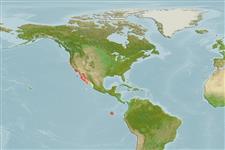Elasmobranchii (tubarões e raias) (sharks and rays) >
Myliobatiformes (Stingrays) >
Myliobatidae (Eagle and manta rays)
Etymology: Myliobatis: Greek, mylo = mill + Greek, + Greek, batis,-idos = a ray (Raja sp.) (Ref. 45335).
More on author: Gill.
Environment: milieu / climate zone / depth range / distribution range
Ecologia
marinhas demersal; intervalo de profundidade 0 - 108 m (Ref. 96339). Subtropical; 43°N - 5°S, 126°W - 85°W (Ref. 55258)
Eastern Pacific: Oregon, USA to Gulf of California (Ref. 2850) and the Galapagos Islands (Ref. 28023).
Tamanho / Peso / Idade
Maturity: Lm ? range ? - ? cm
Max length : 180 cm WD macho/indeterminado; (Ref. 2850); common length : 100.0 cm WD macho/indeterminado; (Ref. 9257); peso máx. Publicado: 82.1 kg (Ref. 40637)
Commonly found in sandy and muddy bays and sloughs, also on rocky bottom and in kelp beds (Ref. 2850). Sometimes buries itself in sand (Ref. 2850). Found singly or in schools (Ref. 12951). Feeds on bivalves, snails, polychaetes, shrimps, and crabs (Ref. 9257). Ovoviviparous (Ref. 50449). Venomous spine on tail. Not fished commercially, but shows up as by-catch species (Ref. 9257).
Exhibit ovoviparity (aplacental viviparity), with embryos feeding initially on yolk, then receiving additional nourishment from the mother by indirect absorption of uterine fluid enriched with mucus, fat or protein through specialised structures (Ref. 50449).
McEachran, J.D. and G. Notarbartolo di Sciara, 1995. Myliobatidae. Aguilas marinas. p. 765-768. In W. Fischer, F. Krupp, W. Schneider, C. Sommer, K.E. Carpenter and V. Niem (eds.) Guia FAO para Identification de Especies para los Fines de la Pesca. Pacifico Centro-Oriental. 3 Vols. FAO, Rome. (Ref. 9257)
Categoria na Lista Vermelha da IUCN (Ref. 130435)
Utilização humana
Warning: mysqli::__construct(): (HY000/1040): Too many connections in /var/www/html/includes/func_getlabel.php on line 46
Can't connect to MySQL database (fbapp). Errorcode: Too many connections
